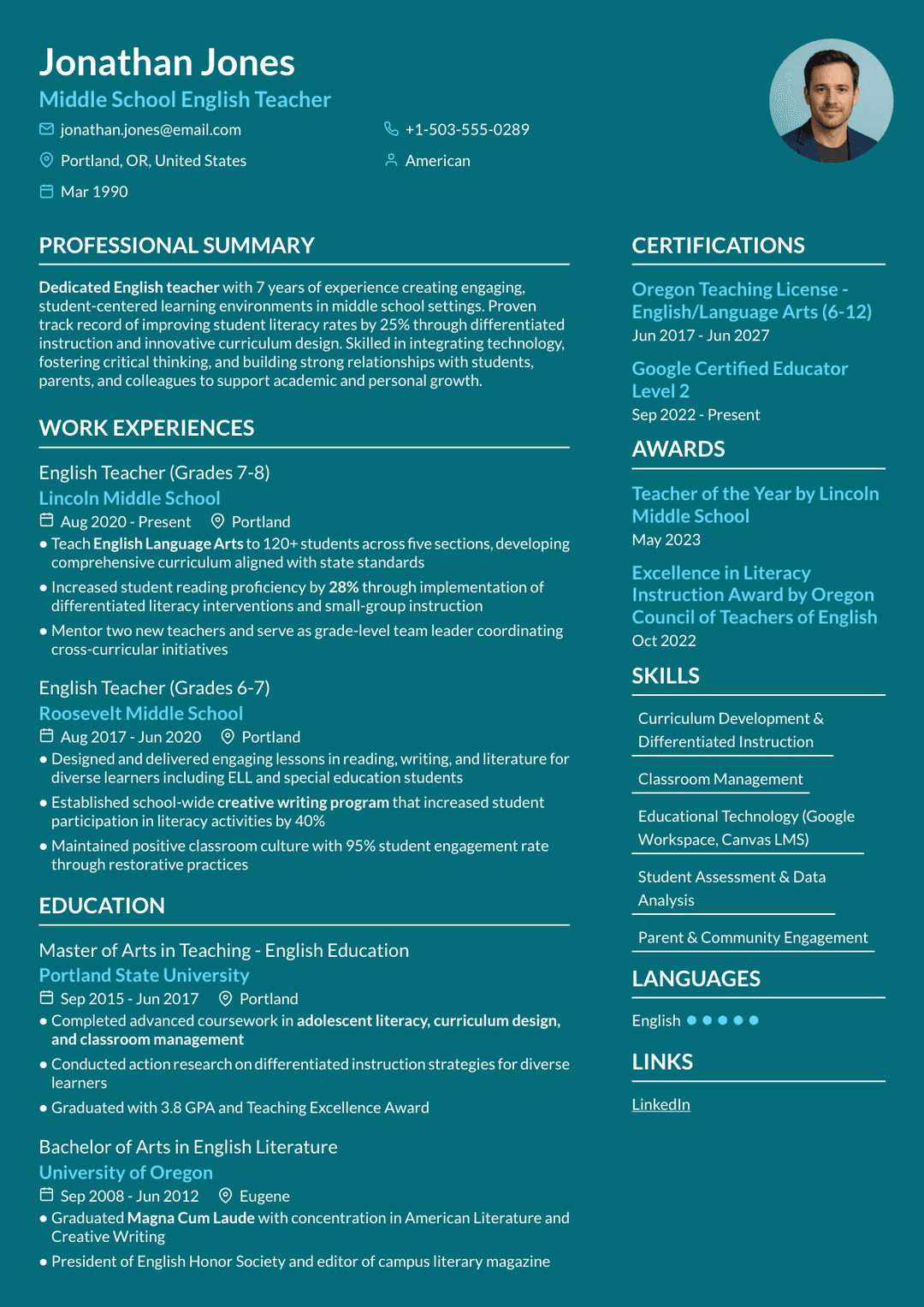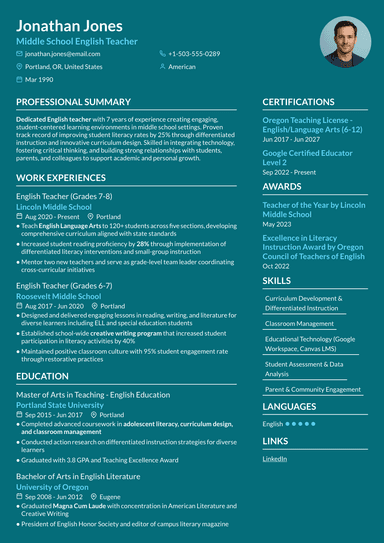How to Write a Teacher Resume: Examples & Tips for 2025
This complete guide with detailed explanations and expert tips will teach you how to write an acting resume in record time!
Edit this resume
Landing a teaching position isn't what it used to be. With schools receiving hundreds of applications for single openings, your resume needs to do more than list where you've taught. It's got to prove you can actually make a difference in students' lives.
Also, a well-crafted teacher resume doesn't just get you past the automated screening systems, it shows principals and hiring committees that you understand modern teaching demands and that you've got the results to back it up.
In this guide, we’ll show you everything you need to know when writing a teacher resume, as well as provide examples and expert tips to improve your chances in landing a job.
- Your credentials matter, but your classroom impact matters more. Educational qualifications get you in the door, but quantifiable student achievement keeps you in the conversation.
- School districts use applicant tracking systems just like corporations, and poorly formatted resumes get filtered out before humans ever see them.
- Numbers, such as test score improvements, class sizes managed, curriculum units developed, tell your teaching story, and separate you from dozens of other qualified candidates.
- Ongoing certifications, workshops, and continuing education show you're keeping pace with educational innovations.
- Tailoring your resume to each specific position can triple your interview callback rate while mirroring language from job descriptions helps both ATS systems and human readers see you as the right fit.
What Makes a Teacher Resume Different?
Teacher resumes operate in their own universe because the education sector requires a completely different skill set than most professions.
On average, 66,200 openings for high school teachers are projected each year, and schools aren't just hiring someone with subject knowledge. They're hiring classroom managers, curriculum designers, assessment specialists, child development experts, and community builders all rolled into one person, and your resume needs to reflect this complexity.
Also, your teaching resume needs to demonstrate your ability to facilitate learning rather than just deliver content. That's why phrases like "implemented differentiated instruction" and "utilized formative assessment" matter so much.
Furthermore, schools want to see evidence of your commitment to the whole school community, something that most career-changers miss. Coaching the debate team, chaperoning field trips, serving on committees often decide between equally qualified candidates.
Which Format to Choose for Your Teacher Resume?
Formatting might seem minor, but the wrong resume format can bury your best qualifications or get your resume rejected by applicant tracking software (ATS).
Here are the three main formats you can choose for your teacher resume:
- Reverse-chronological format. As the gold standard for teachers, it lists work experience starting with the most recent position and working backwards. The structure follows this pattern: contact information → summary → certifications → education → experience → skills → additional sections. This is what hiring managers expect, ATS systems parse easily, and it clearly shows your career progression.
- Functional format. This format focuses on skill categories rather than chronological work history. Best for career changers, teachers with employment gaps, or new teachers without much formal experience. However, many hiring managers view functional resumes skeptically, and ATS systems sometimes struggle with this format.
- Combination/hybrid format. This blends both approaches—robust skills section followed by reverse-chronological work history. It’s best for experienced teachers changing grade levels or subject areas, or returning after time off.
How to Write a Teacher Resume: Key Sections Explained
Writing an effective resume for a teaching position implies including specific sections that education recruiters and principals expect to find. Miss one, and you'll raise questions about your attention to detail.
Let’s examine which section to include in your teacher resume and how to structure them.
#1. Contact Information
Your resume header should include:
- Full name (the one matching your teaching certification)
- Phone number
- Email address
- City and state
If you have a teaching portfolio website or a professional LinkedIn profile, include those as well. However, skip photos unless the job advertisement specifies it.
#2. Professional Summary or Objective
In this resume section, new teachers and experienced educators need different approaches. If you've been teaching for a few years, use a professional summary—a 2-3 sentence snapshot of your teaching strengths and notable achievements.
On the other hand, if you’re a first-year teacher, you should go with an objective statement instead, focusing on teaching philosophy and what you bring from your preparation program. Either way, include keywords that match the job description.
#3. Teaching (Work) Experience
Your work experience section is where you showcase that you can actually teach. Structure each position with:
- Job title
- School name
- Location
- Dates of employment
Use bullet points to describe your achievements, not just your responsibilities. If you’re a new teacher, you should include your student teaching placements here.
When structuring the bullet points, use dynamic, teaching-specific action verbs and quantifiable achievements.
Here's how a bullet points list should look like:
- Increased average state test scores from 67% to 84% proficiency through targeted intervention
- Managed heterogeneous classroom of 32 students including 8 ELLs and 6 students with IEPs, maintaining 98% attendance
- Developed 12 cross-curricular STEM units, resulting in 40% increase in student engagement
- Mentored 4 student teachers with all receiving 'highly effective' ratings
- Increased family engagement by 45% through weekly digital newsletters
Also, read the job description and identify the key priorities and mirror that language in your experience descriptions. If the posting emphasizes "data-driven decision making," showcase how you used assessment data to adjust instruction. This isn't about lying—it's about positioning your genuine experience using their language.
#4. Teaching Certifications and Licenses
When it comes to the certifications and licenses section, list every valid teaching certification you hold. Make sure to include:
- Certification name
- Issuing state or body
- License number (if required)
- Expiration date.
#5. Education
As for education on resume, list your degrees in reverse chronological order—most recent first. Here you should include:
- Degree type
- Major or specialization
- Institution's name
- Graduation date
- Academic honors
Also, if you're a recent graduate with a GPA of 3.5 or higher, include it.
#6. Skills Section
Balance your hard skills with soft skills, and weave in ATS-friendly keywords pulled directly from job descriptions.
Here are some technical skills related to teaching to include:
- Curriculum design and development
- Backwards design and Understanding by Design (UbD)
- Differentiated instruction strategies
- Universal Design for Learning (UDL)
- Formative and summative assessment creation
- Data analysis and interpretation
- Standards-based grading
- Positive Behavioral Interventions and Supports (PBIS)
- Educational technology platforms (Google Classroom, Canvas, Schoology, Seesaw)
- IEP development and implementation
- Response to Intervention (RTI)
- Common Core State Standards alignment
Now that we’ve listed hard skills, let’s see which soft skills to include in your teacher resume:
- Communication
- Parent-teacher conference facilitation
- Collaboration
- Adaptability to different learning environments
- Organization and time management
- Problem-solving and conflict resolution
- Cultural competency and inclusivity
- Leadership through grade-level or department roles
Teacher Resume Examples by Experience Level
What works for a first-year teacher looks totally different from what an experienced teacher should showcase. Let’s examine the two examples below and see how they differ.
First-Year Teacher Resume Example
Experienced Teacher Resume Example
Best Formatting Practices for a Teacher Resume
Beyond choosing the right format and writing, make sure your resume looks professional and polished. Let’s see how to achieve this in more detail.
Design and Layout Guidelines
Keep in mind the following tips when formatting your teacher resume:
- Fonts. Stick with standard, professional fonts that are easy to read, such as Arial, Calibri, Georgia, or Times New Roman. Size should be 10-12 points for body text, 14-16 for your name, 12-14 for section headers.
- Margins and spacing. Use 0.5 to 1-inch margins on all sides. Single spacing within sections, add space between sections for clear visual separation.
- Section headers. Use bold, slightly larger text. Keep them left-aligned. Don't get creative—"Professional Experience" is better than cutesy variations that ATS won't recognize.
- Length. New teachers should limit to one page, while experienced educators with 10+ years can extend to two pages.
- File format. Save as PDF unless the application specifically requests .DOCX.
- Avoid graphics. Don't use text boxes, tables, headers/footers for critical information, images, graphics, or unusual formatting.
- Consistency. Use the same bullet style throughout, uniform date formatting, present tense for current positions, past tense for previous ones.
How to optimize for ATS?
Optimizing for ATS means making your resume meet a threshold to be forwarded to humans. Here’s how to do it:
- Mirror job description language. If the posting says "differentiated instruction," use that exact phrase—not "individualized learning." ATS systems look for specific keywords and don't recognize synonyms.
- Use standard section headers. ATS is programmed for "Work Experience," "Education," "Skills," "Certifications." It doesn't know how to handle creative alternatives.
- Spell out acronyms on first use. Write "Individualized Education Program (IEP)" or "Response to Intervention (RTI)" first, then use just the acronym.
- Match certification names exactly. Use official titles exactly as they appear on your certificate.
- Submit in requested format. If they say .docx, don't send PDF. The ATS is optimized for specific file types.
- Keep formatting clean. Standard fonts, simple bullet points, no text boxes, no tables, no graphics, no images.
- Don't hide information in headers or footers. Put contact information in the main body—many ATS systems ignore headers and footers.
5 Common Teacher Resume Mistakes to Avoid
Even qualified educators make resume mistakes that cost them interviews. The table below outlines the 5 most common ones and how to address them:
| Common Mistake | Why It Hurts Your Resume | The Fix |
|---|---|---|
Being Generic | Principals can tell when you’ve mass-applied—your resume feels impersonal and unfocused. | Spend 15–20 minutes tailoring each resume. Highlight relevant experience and include keywords directly from the job description. |
Focusing on Duties Instead of Achievements | Listing job duties reads like a generic job description and fails to show impact. | Turn duties into measurable achievements. For example, replace “Taught reading to small groups” with “Facilitated reading instruction for 4–6 students, increasing proficiency by 1.8 grade levels.” |
Neglecting Keywords and ATS Optimization | Without keywords, your resume might never reach a human—ATS filters it out first. | Use the job description as a keyword map. Incorporate specific skills, tools, and terms naturally throughout your resume. |
Including Irrelevant Information | Old or unrelated experience distracts from your qualifications and wastes space. | Keep only details that strengthen your candidacy. Omit personal info, outdated jobs, unrelated hobbies, and references. |
Create Your Teacher Resume With ResumeBuilder.so
You could spend hours formatting a resume in Word, fighting with alignment, wondering about keywords, and crossing your fingers about ATS screening. However, with ResumeBuilder.so's AI-powered resume builder the process becomes much more easy. With our platform, you get:
- Teacher-specific resume templates
- AI-powered content suggestions based on your teaching experience
- Automatic ATS optimization
- Easy customization for different teaching positions
- Professional designs that make strong first impressions
- Real-life resume examples that landed interviews
Most importantly, ResumeBuilder.so helps you create a submission-ready teacher resume in minutes rather than hours.
Final Thoughts
Creating an effective teacher resume comes down to a few key principles:
- Tailor each resume to specific positions
- Emphasize quantifiable achievements demonstrating student learning impact
- Ensure ATS compatibility through proper formatting and keywords
- Highlight relevant certifications and ongoing professional development
- Show well-roundedness through extracurricular involvement
- Proofread carefully
Your resume is your first opportunity to demonstrate the attention to detail, communication skills, and professionalism essential for effective teaching. With the right approach and tools like ResumeBuilder.so, you can create a compelling resume that accurately represents your skills and opens doors to rewarding teaching positions.
Teacher Resume FAQ
#1. How long should a teacher resume be?
One page for new or early-career educators with less than five years. You can extend to two pages if you've got 10+ years of experience, extensive accomplishments, published research, or significant leadership roles. Focus on relevant, impactful information—a strong one-page resume beats a padded two-page resume.
#2. Should I include my teaching philosophy on my resume?
No, save detailed teaching philosophy for your cover letter or portfolio. Instead, briefly incorporate elements into your professional summary using phrases like "student-centered educator" or "advocate for differentiated instruction." This gives hiring managers a quick sense without taking valuable space.
#3. What's the best resume format for teachers?
The reverse-chronological format is typically best because it clearly shows career progression and teaching experience in a way principals expect. It works well with ATS systems school districts use. Only deviate if you've got specific circumstances like significant career gaps or you're making a career change.
#4. How do I write a teacher resume with no experience?
Emphasize student teaching placements as legitimate teaching experience. Highlight practicum experiences and volunteer work with children. Include relevant coursework and projects demonstrating your understanding of pedagogy. Mention tutoring, coaching, or camp counseling. Focus on enthusiasm, fresh knowledge of current approaches, and commitment to student success.
#5. Should I include all my teaching certifications?
Include all current, valid teaching certifications relevant to positions you might apply for. List certification type, grade levels, subject areas, state, and expiration date. Multiple certifications make you more versatile. Only list expired certifications if recently expired and you're actively renewing.
#6. How do I address career gaps on my teacher resume?
Be honest about employment gaps but focus on relevant activities during that time—raising children, caring for family, pursuing education, volunteering, professional development. Use your cover letter to address significant gaps more thoroughly and emphasize current readiness. Many educators take time off for legitimate reasons, and principals understand this.
#7. Should I include references on my teacher resume?
Don't include references or "References available upon request"—this wastes valuable space. Prepare a separate reference list with 3-5 professional references to provide when specifically requested. Make sure you've asked permission and they're prepared to speak about your teaching abilities.
#8. How often should I update my teacher resume?
Update at least annually, even if not actively job searching. Add new certifications immediately, incorporate professional development as you complete it, note significant awards. Keep a running document of accomplishments throughout the year so you don't forget important details later.
#9. Can I use the same resume for different teaching positions?
Use a master resume as your starting point, but always customize for each specific position. Adjust your summary to match grade level and subject. Emphasize relevant experience. Incorporate keywords from the job description. Tailored resumes significantly improve interview chances—sometimes by 50% or more.
#10. Should I include my GPA on my teacher resume?
Include GPA only if you're a recent graduate (within three years) and it's 3.5 or higher. Experienced teachers should remove GPA and focus on professional accomplishments, student achievement data, and teaching effectiveness metrics.
#11. Do I need a different resume for each grade level I apply to?
Yes, customize when applying to significantly different grade levels. These positions require different skill sets and approaches. Emphasize experience relevant to the specific grade level, adjust your summary to reflect the developmental stage, and highlight appropriate methodologies.


